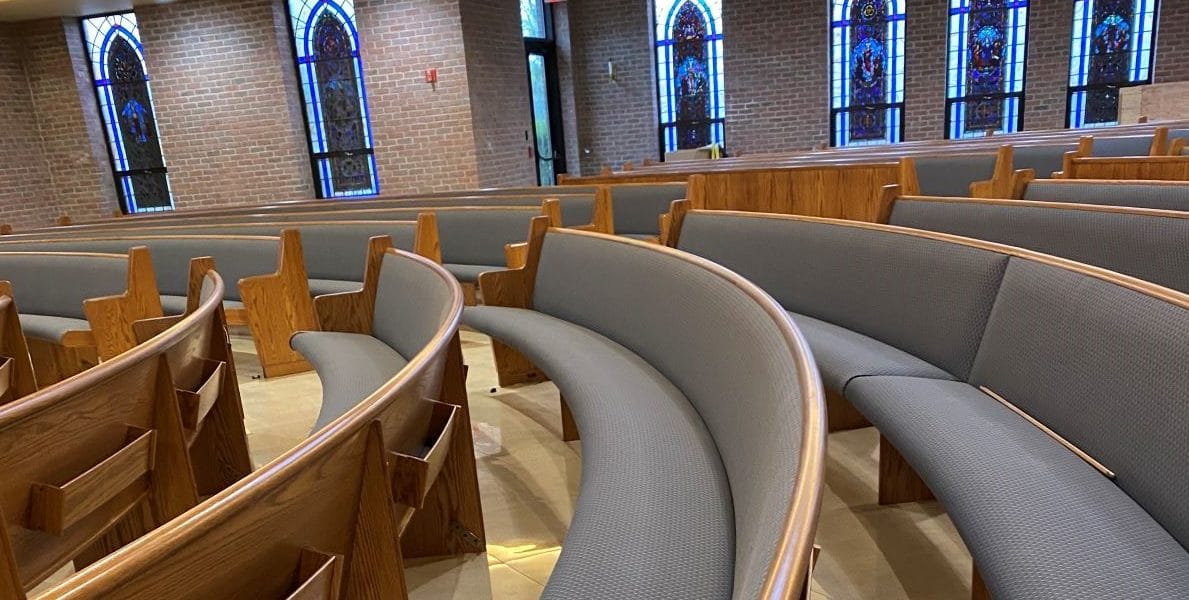The recent outbreak of the COVID-19 (Corona) virus has created multiple challenges for houses of worship. The CDC has suggested that coronavirus may remain viable for hours to days on surfaces made from a variety of materials. Cleaning of visibly dirty surfaces followed by disinfection is a best practice measure for prevention of COVID-19 and other viral respiratory illnesses in households and community settings.
There have been many inquiries from our customers about what is recommended to be used to disinfect church pews, wood furniture and other surfaces in their church.
We understand the desire to use aggressive cleaning agents, including bleach-based disinfectants, to stop the spread of germs on the church pews and surfaces. Unfortunately, the finishes can be damaged by repeated applications of harsh detergents or disinfectants that contain alcohol or other dry solvents.
According to L. Jeff Bishop, technical advisor for Society of Cleaning and Restoration Technicians (SCRT), a nonprofit trade group, “Most consumers are looking for fast, inexpensive and effective ways to clean and disinfect furnishings and fixtures. However, often they are victims of overly simplistic advertising: ‘One spray in the middle of a room disinfects everything!’ This is not credible nor possible.”
Cleaning Recommendations for Your Church Furniture
You have made a significant investment in your church furniture, and we have gathered some recommendations to help you take care of it. These recommendations are published in good faith and for general information purpose only.
Wear disposable gloves when cleaning and disinfecting surfaces. Gloves should be discarded after each cleaning. If reusable gloves are used, those gloves should be dedicated for cleaning and disinfection of surfaces for COVID-19 and should not be used for other purposes. Clean hands immediately after gloves are removed.
If surfaces are dirty, they should be cleaned using a detergent or soap and water prior to disinfection.
Washing Wood Pews and Other Wood Surfaces
Identify the type of finish on your wood surface: a hard finish or an oil one.
- Get some boiled linseed oil, available at hardware stores.
- Rub a few drops into a hidden part of the furniture (in case it affects the stain).
- If the oil beads up, you have a hard finish. If the oil gets absorbed, you have an oil finish.
Cleaning Furniture with Hard Finishes
You may use a common spray cleaner or want to make a mild detergent solution. Prepare a simple mixture of warm water with a mild detergent (any major household brand will do). Mix 1 tablespoon of mild detergent for every 3 gallons of water. This method is best to clean off soils and germs.
Bishop says, “Furniture that is painted or has multiple coats of finish can be damaged by repeated applications of harsh detergents or disinfectants that contain alcohol or other dry solvents.”
Cleaning Furniture with an Oil Finish
- Start with three soft, lint-free cloths. If you’re using a rag of clothing or an old shirt, make sure buttons and seams are removed so they don’t scratch the furniture.
- Dip one cloth in a sudsy, mild soap and water solution. Wring it out thoroughly and use it to scrub the furniture. Then wet the second cloth with water and use it to rinse the soap off the furniture’s surface. Finally, dry with the last cloth.
- Continue this cleaning method for the entire wood surface, overlapping the previously washed areas.
CAUTION:
- Never clean wood furniture with a hose or excessive water. Standing water will cause significant damage to wood furniture.
- Never use a water-based polish or polish containing wax. These will ruin the finish of the wood.
How To Disinfect Wood Pews and Wooden Church Surfaces
- Fill a spray bottle with 2 cups water, 1 cup white vinegar and about five drops dish soap. The vinegar disinfects and the dish soap works as an added cleaning element.
- Spray the solution onto the wood areas and wipe off with a damp cleaning rag. Using a damp rag removes traces of the vinegar and soap. Continue across the wood section until the area is cleaned and disinfected.
- Wipe the furniture with a dry-cleaning rag to remove any excess moisture. Be sure to dispose of any rags and cleaning materials.
Cleaning Upholstered Church Pews and Chairs
You can disinfect your wood pews, doorknobs and even light switches, but what about your upholstered pews? It’s possible, but don’t reach for that can of disinfecting aerosol spray just yet.
Here’s the safe way to disinfect your furniture without harming it, according to Bishop.
Vacuum
Use your vacuum cleaner on upholstered cushions. Make sure the vacuum has a ULPA or HEPA filter. Vacuuming fabrics with the upholstery and crevice attachments (nothing with harsh bristles) keeps dirt from building up and wearing into furniture over time.
Spray
For loose pew cushions, don’t take cushions out of their covers to clean them. The covers might shrink in the wash and no longer fit over the cushion. Instead, apply a spray-on, water-based detergent, like an upholstery-cleaning detergent or liquid soap and water.
You can also use a homemade disinfectant comprising a 2-to-1 ratio of 60 to 90 percent rubbing — isopropyl — alcohol to water. Check the labels on your upholstery before shopping for a detergent, since each type of fabric can have different recommendations. And test the cleaning solution on a less noticeable spot to make sure it doesn’t discolor the fabric.
Agitate, Wait, Wipe
Rub in the detergent uniformly to avoid spots and uneven drying patterns. Then wait 5 to 10 minutes for the detergent to dissolve into the fabric and suspend the dirt and oils. Wipe the residue away from the surface with a clean cloth. Allow the fabric to dry completely to prevent a moist environment where microorganisms can grow.
“These steps not only kill most viruses and bacteria, but also rinse and remove suspended soils from fabrics,” says Bishop.
If your upholstery is old and worn, you may want to consider beginning the process of replacement. Newer fabrics and foams have built-in antimicrobial characteristics.
This information is courtesy of Artech Church Interiors, which offers church and synagogue restoration and renovation, including pews, audio, church lighting, painting, and flooring, www.artechchurchinteriors.com.














